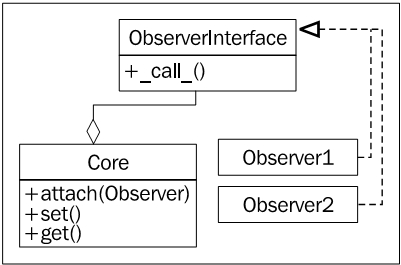The observer pattern is useful for state monitoring and event handling situations. This pattern ensures a single core object can be monitored by an unknown, possibly expanding, array of "observer" objects. Whenever a value on the core object changes, it lets all the observer objects know that a change has occurred, by calling an update() method. Each observer may be responsible for different tasks whenever the core object changes; the core object doesn't know or care what those tasks are, and the observers don't typically know or care what other observers are doing. Here it is in UML:

The observer pattern could be useful in a redundant backup system. We can write a core object that maintains certain values, and then have one or more observers create serialized copies of that object. These copies might be stored in a database, on a remote host, or in a local file, for example. Let's implement the core object using properties:
class Inventory: def __init__(self): self.observers = [] self._product = None self._quantity = 0 def attach(self, observer): self.observers.append(observer) @property def product(self): return self._product @product.setter def product(self, value): self._product = value self._update_observers() @property def quantity(self): return self._quantity @quantity.setter def quantity(self, value): self._quantity = value self._update_observers() def _update_observers(self): for observer in self.observers: observer()
This object has two properties that, when set, call the _update_observers method on itself. All this method does is loop over the available observers and let each one know that something has changed. In this case, we call the observer object directly; the object will have to implement __call__ to process the update. This would not be possible in many object-oriented programming languages, but it's a useful shortcut in Python that can help make our code more readable.
Now let's implement a simple observer object; this one will just print out some state to the console:
class ConsoleObserver:
def __init__(self, inventory):
self.inventory = inventory
def __call__(self):
print(self.inventory.product)
print(self.inventory.quantity)
There's nothing terribly exciting here; the observed object is set up in the initializer, and when the observer is called, we do "something." We can test the observer in an interactive console:
>>> i = Inventory()
>>> c = ConsoleObserver(i)
>>> i.attach(c)
>>> i.product = "Widget"
Widget
0
>>> i.quantity = 5
Widget
5
After attaching the observer to the inventory object, whenever we change one of the two observed properties, the observer is called and its action is invoked. We can even add two different observer instances:
>>> i = Inventory()
>>> c1 = ConsoleObserver(i)
>>> c2 = ConsoleObserver(i)
>>> i.attach(c1)
>>> i.attach(c2)
>>> i.product = "Gadget"
Gadget
0
Gadget
0
This time when we change the product, there are two sets of output, one for each observer. The key idea here is that we can easily add totally different types of observers that back up the data in a file, database, or internet application at the same time.
The observer pattern detaches the code being observed from the code doing the observing. If we were not using this pattern, we would have had to put code in each of the properties to handle the different cases that might come up; logging to the console, updating a database or file, and so on. The code for each of these tasks would all be mixed in with the observed object. Maintaining it would be a nightmare, and adding new monitoring functionality at a later date would be painful.
